**Introduction**
In the digital age, the concept of education has transcended traditional classroom boundaries, extending into the comfort of our homes. Learning at home for kids is not just a necessity in times of global crises, such as pandemics, but a sustainable model of education that complements formal schooling. This innovative approach encourages children to embrace learning as a continuous, engaging, and dynamic process. Here, we explore the essential components of effective home learning, ensuring that it is both enjoyable and enriching.
Crafting a Dedicated Learning Space
The physical environment where children learn plays a pivotal role in how effectively they can focus and absorb information. A dedicated learning space does not necessarily require a large room or elaborate furniture. Instead, it should be a specific, organized area in the home that minimizes distractions. This space should be equipped with the necessary supplies like stationery, textbooks, and digital devices if needed. Personalizing the space with items that inspire creativity and concentration can make learning more inviting and enjoyable for children.
Incorporating Technology Wisely
While technology can greatly enhance learning, its use should be wisely moderated. Educational apps and websites offer interactive and personalized learning experiences that are both fun and educational. However, it’s crucial to ensure that screen time is balanced with other forms of learning. Tools like digital timers or parental control apps can help manage the amount of time spent on devices, ensuring that technology acts as a complement to learning, rather than a distraction.
Engaging with Real-World Projects
One of the most effective ways to enhance learning at home is to engage children in projects that connect educational content with real-world applications. This could involve science experiments in the kitchen, art projects in the backyard, or even a small business project like a lemonade stand. These activities encourage children to apply what they’ve learned in practical settings, which can deepen their understanding and retention of knowledge.
Fostering a Reading Culture
Developing a love for reading is one of the greatest gifts you can give to a child. Designate a reading hour daily where all family members read individually or to each other. This not only improves literacy and language skills but also helps in developing empathy, creativity, and critical thinking. A home library or a subscription to a children’s book club can be a great investment in your child’s educational journey.
Encouraging Self-Directed Learning
Encouraging children to take initiative in their learning process is crucial for developing lifelong learners. This involves giving them the freedom to explore topics of interest, ask questions, and make decisions about how they want to learn. Parents can facilitate this by providing resources, guiding their research, and encouraging them to set goals and assess their progress. This approach helps build independence, confidence, and a deep-seated love for learning.
**Conclusion**
Learning at home offers a unique opportunity to tailor educational experiences to a child’s individual needs, interests, and pace. By creating a conducive learning environment, wisely integrating technology, engaging in hands-on projects, fostering a reading culture, and encouraging self-directed learning, parents can significantly enhance their children’s educational outcomes. Home learning is not just about academic development but about nurturing a well-rounded, curious, and knowledgeable individual ready to face the world’s challenges.




